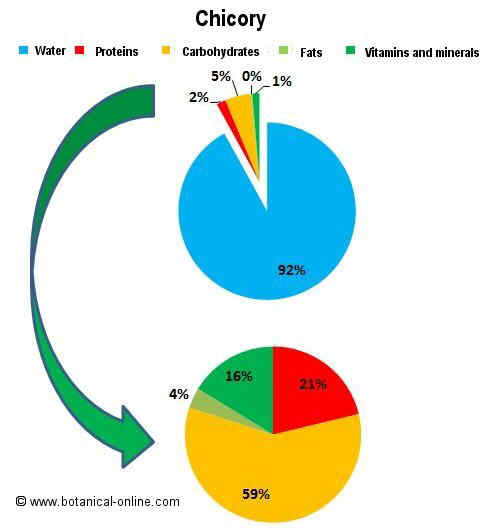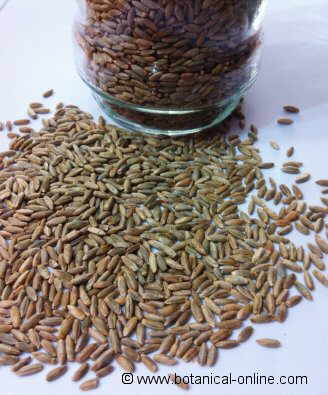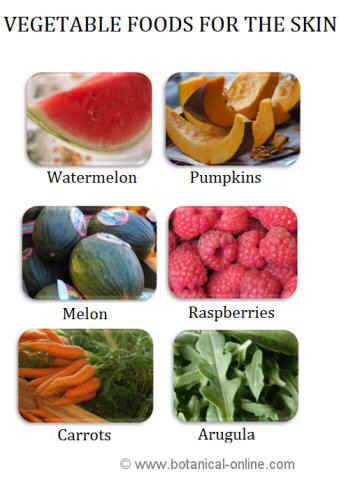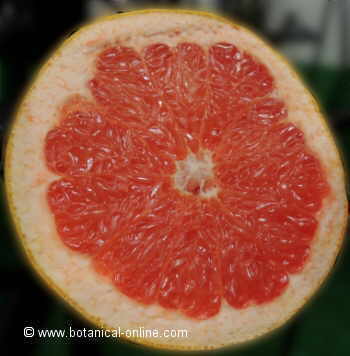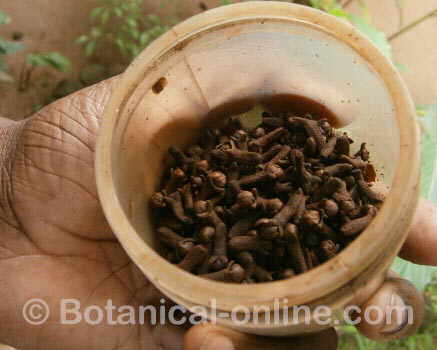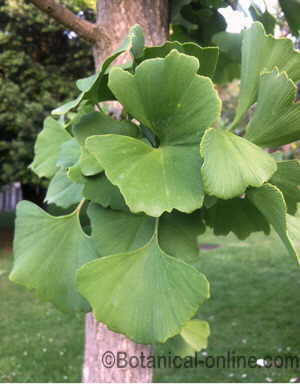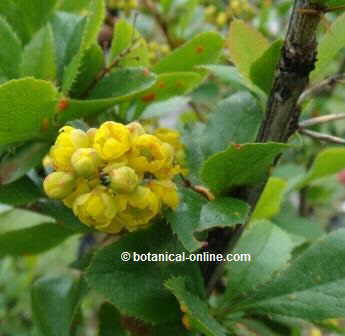Contents
- 1 CHARACTERISTICS OF HEMLOCK (Conium maculatum)
- 1.1 Habitat: Were to find hemlock?
- 1.2 What is hemlock like? Hemlock description
- 1.3 Hemlock composition
- 1.4 USES OF HEMLOCK
- 1.5 Medicinal uses of hemlock
- 1.6 Hemlock as a classic poison
- 1.7 Toxicity of hemlock
- 1.8 Hemlock poisoning symptoms
- 1.9 Medical treatment for hemlock poisoning
- 1.10 Is hemlock toxic for animals?
CHARACTERISTICS OF HEMLOCK (Conium maculatum)
Scientific name: Conium maculatum L. The name comes from the Greek Koneion, which is how the Greeks called this plant and maculatum that in Latin means “spotted” and refers to the stains this plant has on the stems.
Common English name: Hemlock, poison hemlock, Spotted Corobanem, Devil’s Bread, Poison Parsley, Herb Bennet, spotted henbane, poisonous henbane.
Common name in other languages:
Spanish: Cicuta, perejil lobuno
French: Ciguë tachetée
Catalan: Cicuta, ciguda, julivertassa
Euskara: Otzerri-belar
Italian: Cicuta
Portuguese: Cicuta, asta-perrezil, cegude,
German: Gefleckte Schierling
Dutch: gevlekte scheerling
Family: Umbelliferae
Habitat: Were to find hemlock?
It is a ruderal and nitrophilous plant. Common in some fresh and shady uncultivated places, rubble, along ditches, abandoned gardens.
Originally from Europe, it spread to western Asia and North Africa, although it can be found naturalized in many regions of the world. Today, it abounds in South America, especially in Argentina, New Zealand, India or South Africa. In the United States it can be found naturalized in the eastern states.
What is hemlock like? Hemlock description
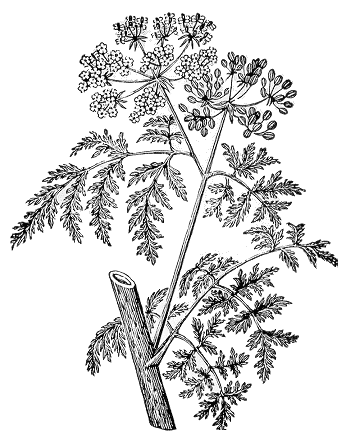 Drawing of a branch of hemlock
Drawing of a branch of hemlock
Biennial plant belonging to the Umbelliferae. All of it has a foul smell that has been compared to cat urine. It is also said that it smells to mice. The smell gets stronger when the plant is squeezed or rubbed.
Its taste is slightly bitter and unpleasant. Both his smell as well as its taste makes it quite difficult to confuse with parsley or another plant of the same family.
More or less thick stems up to more than 3 meters tall (usually between 1 and 3 meters), cylindrical, fistulous, smooth, plenty mainly in its base and its branches of violet or purple spots.
Large leaves, pinnatifid, shiny pale green. White flowers on terminal umbels with 5 heart-shaped petals, 2-4 mm in diameter. It blooms from May to July.
Its fruit is a globular diachene with five ribs.
Hemlock composition
- Alkaloids: Gammaconiceine, coniine, conhydrine, pseudoconhydrine (plant)
- Flavonoids: diosmin (plant)
- Acids: caffeic, chlorogenic, uronic (plant)
- Proteins: (seeds)
- Fats: (seeds)
- Carbohydrates: arabinose, lignin, pentosans, xylose (plant)
Active parts: Leaves and fruits.
USES OF HEMLOCK
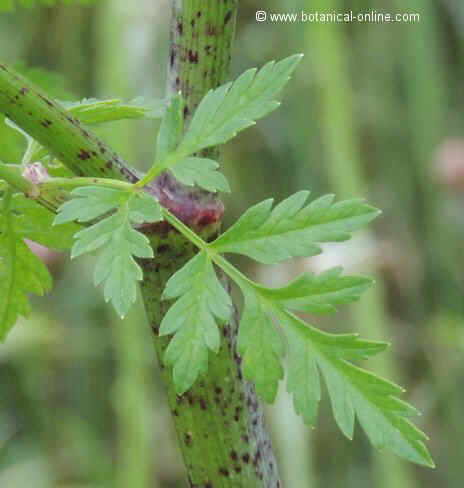
Photo of a leaf of hemlock in which the stem appears with the distinctive purple spots
Medicinal uses of hemlock
- Home Remedies with hemlock: In traditional medicine, hemlock has been used to treat jaundice, pain, for syphilis, epilepsy, cavities, asthma, tetanus, etc. It is usually administered as a substitute opium extract.
- In official medicine, it is used in formulas of local analgesics. Hemlock medicines can alleviate pain.
Because it is a poisonous plant, it should not be used as a homemade remedy
Hemlock as a classic poison
In Europe, Greece and Rome, hemlock was used as a usual poison.
American Indians profited this plant to make a concoction with which they poisoned arrows
Toxicity of hemlock
Hemlock is a very poisonous plant. The toxicity depends on the temperature and the soil where it grows. In hot countries the toxicity index is higher than in countries with lower temperature. There are even references that in cold countries this plant has virtually no toxicity, while in countries like Italy or Spain toxicity is very high.
There are also references that in some places the plant has been used for food, so some scholars think that cooking could detoxify it.
There are cases of poisoning in people who have confused the leaves of this plant with parsley (Petroselinum crispum). Other times, its root has been confused with the root of the parsnip (Pastinaca sativa).
With hemlock were executed criminals in Athens mixed with opium so that death took place without being aware of it. Apparently it was this mixture that Socrates drank when he was sentenced to death in 399 BC
The philosopher describes how he felt while the poison was acting. He described how his members were becoming paralyzed from the feet up and how he was fully aware as muscle paralysis occurred. His death occurred when the lungs gradually stopped working. So Plato’s accounts in Phaedon:
| “But Socrates, after walking around, now told us he was beginning to feel tired legs and immediately lay down. At the same time, the man who had given him the poison looked at his feet and legs, touching them at intervals. At last, he squeezed so violently on his foot, and asked if he was sorry. To which Socrates said no. The man then pulled the leg and so on, showing that it was becoming cold and stiff. And Socrates, feeling it the same, assured us that when the effects would have amounted to his heart, he would have gone, and now, feeling half his body becoming cold, he threw aside the clothes and spoke for the last time: – Crito, we owe the sacrifice of a cock to Aesculapius. – It will be done – Critón said. Have you anything more to say? He did not answer, but a moment later his eyes remained fixed. And Crito, seeing this, closed his eyelids and mouth “ |
– In contact with the skin: hemlock may cause dermatitis in some people.
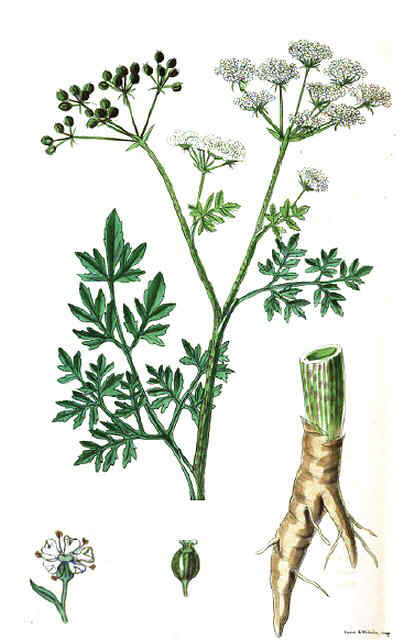 Colored drawing of the plant with details of the root, flower and fruit.
Colored drawing of the plant with details of the root, flower and fruit.
Hemlock poisoning symptoms
The symptoms occur within half an hour after ingestion approximately.
- When doses are very low, the main symptoms are:
- Dizziness
- Nausea
- Weakness.
These symptoms usually last about 12 hours or more.
- When doses are higher, the main symptoms are:
- Dilated pupils
- Sore throat
- Diarrhea
- Dizziness
- Muscle weakness
- Weak pulse
- Paralysis of the respiratory muscles resulting in death.
Hemlock acts as a stimulant at the beginning of intoxication to become a depression later.
Medical treatment for hemlock poisoning
Gastric lavage, breathing assistance and emetics.
Is hemlock toxic for animals?
Hemlock is very toxic to all animals. According to some experts, only the goats get rid of its toxicity. The poison of this plant acts quickly after one hour of ingestion, leading most of them to death after two or three hours after the poisoning.
Among the main symptoms, animals have difficulty swallowing, convulsions and death by paralysis of the respiratory muscles.
Among all the cattle, those most likely to become intoxicated animals are cows and pigs, while sheep do not notice its effects both.
Poisoning usually occurs when animals eat dry hay contaminated with this plant. It is difficult for them to become poisoned with the tender plant because of the smell and taste makes them usually reject it.
Treatment is similar to that applied to humans: stomach emptying, anticonvulsants and neutralizing products, such as tannic acid.
![]() More information on hemlock.
More information on hemlock.

